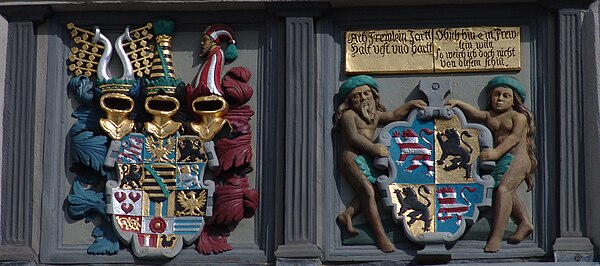Duchy of Saxony-Hildburghausen

Sachsen-Hildburghausen was an Ernestine duchy in the south of what is now the Free State of Thuringia . It existed from 1680 to 1826.
history
The principality of Saxony-Hildburghausen, which was awarded to the second youngest son, Ernst, was created through the inheritance agreement in 1680 among the seven sons of Duke Ernst I of Saxe-Gotha . The full sovereignty of Gotha was granted in 1702 when the principality was granted sovereignty.
The principality included the office and city of Hildburghausen , the office and city of Heldburg , the office and city of Eisfeld , the office of Veilsdorf and half of the office of Schalkau . In 1683 the Königsberg office was added, and the Sonnefeld office in 1705 . In addition, after the inheritance disputes ended in 1714, the principality received parts of Sachsen-Römhild , the Behrungen winery , the Echter fiefs and Milz in exchange for Schalkau . As a result of the "Schalkauer exchange contract" received the principality in 1723 by the Duchy of Saxe-Meiningen from the Office Meiningen its exclave Queienfeld and out of the office Maßfeld the places Rentwertshausen , Berkach and Schwickershausen (Meiningischer share), which since then with Behrungen the Office Behrungen formed .
In 1684 Hildburghausen became a residential town and developed accordingly. However, the lavish royal court and the buildings of the princes shattered the finances of the principality so badly that from 1769 a compulsory debt management was set up by an imperial debit commission , of which the regent Charlotte Amalie von Sachsen-Meiningen was appointed director.
With the dissolution of the old empire in 1806, Saxony-Hildburghausen also received full sovereignty as the Duchy of Saxony-Hildburghausen, which joined the Rhine Confederation in 1806 and the German Confederation in 1815 . It was one of the first German states to receive a state constitution in 1818 .
The extinction of the line of Saxe-Gotha-Altenburg in 1826 required a reorganization of the Ernestine duchies, Saxony-Hildburghausen fell to the offices of Koenigsberg and Sonnenfeld, the Saxe-Coburg-Gotha to be slammed to Saxe-Meiningen . In return, Duke Friedrich von Sachsen-Hildburghausen took over the Duchy of Sachsen-Altenburg .
Princes and dukes
- 1680–1715 Ernst (1655–1715)
- 1715–1724 Ernst Friedrich I (1681–1724)
- 1724–1745 Ernst Friedrich II. (1707–1745), from 1724 to 1728 under the tutelage of his mother Sophia Albertine von Erbach
- 1745–1780 Ernst Friedrich III. Carl (1727–1780), from 1745 to 1748 under the tutelage of his mother Caroline von Erbach-Fürstenau
- 1780–1826 Friedrich (1763–1834), since 1826 Duke of Saxony-Altenburg ; from 1780 to 1787 under the tutelage of his great-great-uncle Joseph Friedrich
Other people

- Sophia Henriette von Waldeck (1662–1702), Duchess of Saxony-Hildburghausen
- Eugen von Sachsen-Hildburghausen (1730–1795), Prince of Sachsen-Hildburghausen
- Ludwig Friedrich von Sachsen-Hildburghausen (1710–1759), Prince of Sachsen-Hildburghausen
- Joseph Friedrich von Sachsen-Hildburghausen (1702–1787), Prince of Sachsen-Hildburghausen
- Christiane Sophie Charlotte of Brandenburg-Kulmbach (1733–1757), Duchess of Saxony-Hildburghausen
- Ernestine Auguste Sophie of Saxe-Weimar-Eisenach (1740–1786), Duchess of Saxe-Hildburghausen
- Charlotte Georgine Luise of Mecklenburg-Strelitz (1769–1818), Duchess of Saxony-Hildburghausen
- Charlotte von Sachsen-Hildburghausen (1787–1847), by marriage Princess of Württemberg, since then called "Princess Paul of Württemberg"
- Therese von Sachsen-Hildburghausen (1792-1854), by marriage Queen of Bavaria (namesake of Theresienwiese in Munich)
- Luise von Sachsen-Hildburghausen (1794–1825), by marriage to the Duchess of Nassau
literature
- Oliver Heyn: The Military of the Principality of Saxony-Hildburghausen (1680–1806) (= publications of the Historical Commission for Thuringia, Small Series, Vol. 47), Cologne, Weimar, Vienna 2015
- Heinrich Ferdinand Schoeppl: The dukes of Saxony-Altenburg. Bolzano, 1917, reprint Altenburg, 1992
Individual evidence
Web links
- Saxony-Hildburghausen . In: Meyers Konversations-Lexikon . 4th edition. Volume 14, Verlag des Bibliographisches Institut, Leipzig / Vienna 1885–1892, p. 146.




